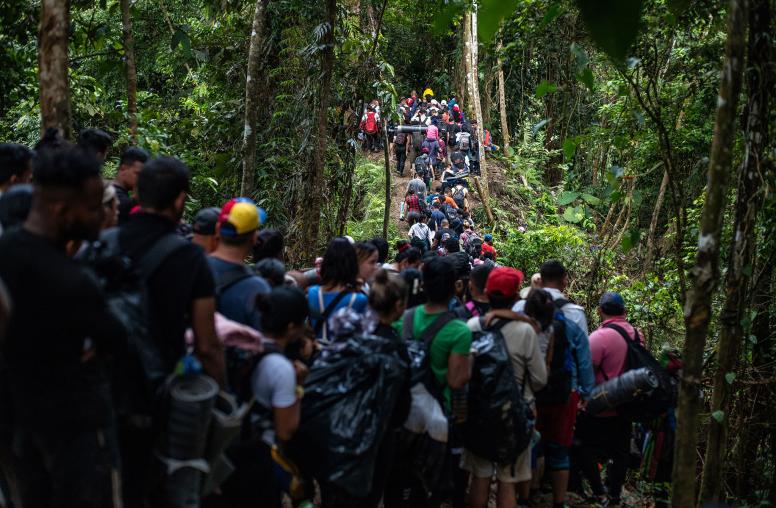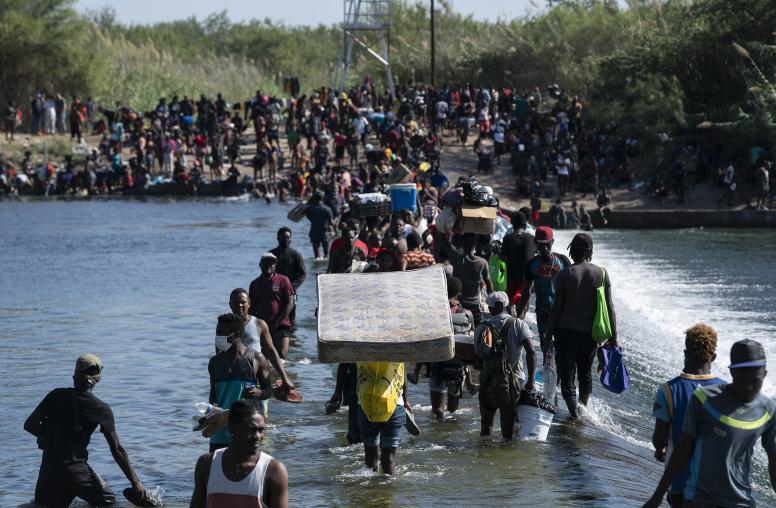How Efforts to Address Conflict and Coronavirus Align
The recently passed Global Fragility Act provides a framework to respond to state fragility—and COVID-19.
As the unprecedented humanitarian and economic impacts of COVID-19 begin to be felt across poor and conflict-affected states, there is a risk that policymakers will lose focus on longer-term priorities—like conflict prevention and economic development. The scale of emergency aid that will be needed is becoming more clear, and the initial projections are staggering: the coronavirus is likely to cause the first increase in global poverty since 1998, with the share of the world’s population living on less than $1.90 per day estimated to surge to 665 million people, while the number of people facing hunger could double by the end of 2020, affecting 265 million. Despite the challenge of addressing these ballooning humanitarian needs, it would be a mistake to walk away from policy frameworks, like the Global Fragility Act (GFA), for tackling the underlying drivers of fragility.

Integrating Peacebuilding and Emergency Relief
Over the past decade, as conflicts around the world became entrenched and humanitarian crises proliferated, aid donors converged around the need for a new approach that would amount to more than just pouring money into costly emergency response efforts. A consensus emerged that aid agencies could reduce the underlying drivers of tensions and increase resiliency to shocks, by responding to crises and simultaneously investing in longer-term development and peacebuilding—through emergency food aid, but also infrastructure and social cohesion programs.
The objective of such “triple nexus” approaches is to respond with an eye to eventually alleviating humanitarian crises and reducing the need for costly relief operations. These approaches have gained currency and are now widely accepted as a smarter way to address crises, even if more work is needed to remove the many obstacles to operationalizing these approaches on the ground.
Today in the U.S., this emerging consensus has culminated in the GFA, an ambitious bill signed into law in late 2019 that aims to overhaul the way the U.S. engages in fragile states—where the social contract between citizens and the state is severed and societies are fragmented and prone to violence. If successfully implemented, this new framework could ultimately transform U.S. policy and assistance in fragile countries, demonstrating an alternative approach to the kinds of multi-billion dollar state-building efforts that have been underway for years in places like Afghanistan and Iraq. In contrast to the new approach laid out in the GFA, U.S. humanitarian, development and security assistance in fragile states has all too often been delivered in the absence of an overarching framework for addressing conflict drivers, building resilience, and reducing humanitarian needs.
As the U.S. begins to work with other donors to address the immediate impacts of the COVID crisis in fragile states, putting into practice the GFA provisions will help ensure that U.S. investments have sustained impact and alleviate the underlying conditions that have already begun to fuel crises. It could also help to build resilience in these countries over time.
The first order of business to advance implementation of the bill is to develop a U.S. strategy and a set of priority country plans through a process of multi-stakeholder consultations, as required under the GFA. The bill requires the executive branch to develop the strategy and country plans in consultation with a wide range of stakeholders at the local, national, and global levels. Establishing a robust consultation process is possible and should be a priority, even if COVID-related restrictions will require innovative thinking and flexibility. The consultation process should be viewed as an opportunity to put into practice the peacebuilding principles embedded in the GFA.
Principles for Successful Multi-stakeholder Dialogues
Multi-stakeholder consultations involve a process of dialogue with actors who have an interest in, or are most likely to be affected by, a policy decision. Broad-based consultations are common practice in the peacebuilding field, in part because they can lead to more comprehensive policy solutions that are well-suited to addressing complex conflict situations. In addition to helping with information-gathering to generate policy solutions, successful consultations adhere to a core set of guiding principles.
First, they tend to be inclusive. Achieving long-term results through dialogue on peacebuilding policy can hinge on whether local actors are not only seen to be involved in setting the agenda, but to help lead the policy process. Effective consultations also seek to achieve accountability and transparency in communication between stakeholders. Establishing clear ground rules from the get-go, such as a consultation timeline and parameters for providing feedback, is key. Another critical factor in successful consultations is the establishment of trust between key stakeholders. A robust, inclusive consultation process can create the conditions for trust building between local communities and the government. Finally, successful multi-stakeholder dialogues are often designed as a vehicle for building consensus. An effective strategy for building consensus is to conceive of the multi-stakeholder consultation as a policymaking system in which stakeholder groups have distinct but complementary roles.
Four Benchmarks for Successful Consultations on the GFA
Using these well-established principles as a guide, the GFA consultations are more likely to result in an innovative and effective policy framework if concrete steps are taken to adhere to the following four standards:
- Engage actors on the frontlines. GFA implementation can get off to a good start if the consultative process includes a seat at the table for frontline peacebuilders. Failing to do so could reinforce the very conflict dynamics that the new policy framework is intended to address, since a narrow process could lead to a perception that those engaged are only elite actors accountable to external rather than domestic constituencies. The Alliance for Peacebuilding has outlined several recommendations for reaching frontline actors even under a lockdown. The World Bank carried out an inclusive consultation process to develop its Fragility, Conflict and Violence Strategy, which could serve as a model for the U.S. consultations. The State Department could also instruct U.S. missions in conflict countries to solicit input from frontline peacebuilders, leveraging online platforms and existing engagements to reduce the burden on mission staff.
- Don’t forget Congress. The GFA consultation period offers an excellent opportunity for agencies to open a more candid and sustained dialogue with Congress on U.S. engagement in fragile states. Building trust among congressional leaders and staff will be imperative to ensure agencies maintain the flexible spending authorities granted by Congress—and obtain the necessary funds—they need to respond to underlying conflict dynamics on the ground. Sustained, open dialogue between the two branches of government will be key both to building the confidence of Congress in executive branch efforts, and to setting adequate expectations about what can be achieved in particular conflict settings. The emphasis should be on demonstrating learning, innovation, and international burden-sharing, rather than pre-determined outcomes that may be divorced from the country context and unrealistic. The agencies with a lead role in the GFA could begin a regular schedule of consultations with key congressional offices as they begin the policy planning process.
- Identify country leaders early on. Decades of failed foreign interventions and political reform efforts that are imposed from the outside have proven that sustainable peace is impossible without local ownership. Local ownership requires recognizing the power asymmetry between international and national actors and in-country civil society groups, and placing authority firmly in the hands of leaders on the ground. Because strong leadership and partnerships with local leaders is perhaps the most important determinant of success in fragile settings, the consultations process should also be viewed as an opportunity to identify and build strong relationships with country leaders. Agencies could begin identifying committed country partners early and use the consultation process to include potential partners in the policy development process from the get-go.
- Bring in U.S. partners. Because the United States cannot achieve the policy objectives set out in the GFA alone, the consultative process should be viewed as an opportunity to ally with multilateral and bilateral donors. Building on the Stabilization Leaders Forum and Global Coalition to Defeat ISIS, agencies could use the consultation period to launch a new partnership with a consortium of international partners that have the commitment and resources necessary to build resilience to conflict and shocks in fragile states.
Amanda Long is an international partnerships assistant at the U.S. Institute of Peace.

